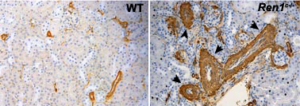Hypoxia and Kidney Vascular Pathology
About
 The renin angiotensin system (RAS) is important for the control of blood pressure and fluid-electrolyte homeostasis. Dr. Gomez and others have shown that inhibition of RAS in mice by genetic ablation of genes encoding components of the system (Ren1, AGT, ACE, and combined AT1A and AT1B receptors) results in abnormal kidney structure accompanied by impaired renal function. A hallmark of all the RAS deficient models is the thickening of the smooth muscle layer of intrarrenal arteries and arterioles. The marked hypercellularity/hypertrophy and thickening of the vessels with narrowing of the lumen may be triggered or exacerbated by tissue hypoxia leading to hypoperfusion, renal ischemia, and subsequent fibrosis. The mechanisms underlying this pathology are unknown. The first defense mechanism against hypoxia is the HIF pathway that activates genes involved in red cell production, angiogenesis, glucose metabolism, cell proliferation and survival. We have recently found that HIF-2α is expressed in juxtaglomerular (JG) cells and that renin cells express erythropoietin (EPO) when HIF-2α is overexpressed in cells of the renin lineage. We hypothesize that when RAS genes are ablated, renin cells become hypoxic and HIF-2α levels in them are increased. As a consequence, renin cells express EPO which induces proliferation of smooth muscle-like cells resulting in thickening of the arterioles. We propose to: 1) characterize the expression patterns of HIF-2α, EPO, EPOR, VEGF and markers of cell proliferation along the kidney vasculature of Ren1c homozygous null mice, and 2) A. determine whether deletion of the renin gene leads to hypoxia in cells of the renin lineage; B. determine whether deletion of HIF-2α in renin cells prevents arteriolar hyperthrophy. The proposed experiments will yield significant information on the role of hypoxia-associated genes in the thickening of kidney arterioles, a pathology that leads to hypoperfusion, ischemia and renal fibrosis, and ultimately to kidney failure. A better understanding of the mechanisms that underlie the thickening of kidney arterioles is of fundamental biological and medical importance. Information gained from the proposed studies may help children and adults affected by kidney diseases and hypertension.
The renin angiotensin system (RAS) is important for the control of blood pressure and fluid-electrolyte homeostasis. Dr. Gomez and others have shown that inhibition of RAS in mice by genetic ablation of genes encoding components of the system (Ren1, AGT, ACE, and combined AT1A and AT1B receptors) results in abnormal kidney structure accompanied by impaired renal function. A hallmark of all the RAS deficient models is the thickening of the smooth muscle layer of intrarrenal arteries and arterioles. The marked hypercellularity/hypertrophy and thickening of the vessels with narrowing of the lumen may be triggered or exacerbated by tissue hypoxia leading to hypoperfusion, renal ischemia, and subsequent fibrosis. The mechanisms underlying this pathology are unknown. The first defense mechanism against hypoxia is the HIF pathway that activates genes involved in red cell production, angiogenesis, glucose metabolism, cell proliferation and survival. We have recently found that HIF-2α is expressed in juxtaglomerular (JG) cells and that renin cells express erythropoietin (EPO) when HIF-2α is overexpressed in cells of the renin lineage. We hypothesize that when RAS genes are ablated, renin cells become hypoxic and HIF-2α levels in them are increased. As a consequence, renin cells express EPO which induces proliferation of smooth muscle-like cells resulting in thickening of the arterioles. We propose to: 1) characterize the expression patterns of HIF-2α, EPO, EPOR, VEGF and markers of cell proliferation along the kidney vasculature of Ren1c homozygous null mice, and 2) A. determine whether deletion of the renin gene leads to hypoxia in cells of the renin lineage; B. determine whether deletion of HIF-2α in renin cells prevents arteriolar hyperthrophy. The proposed experiments will yield significant information on the role of hypoxia-associated genes in the thickening of kidney arterioles, a pathology that leads to hypoperfusion, ischemia and renal fibrosis, and ultimately to kidney failure. A better understanding of the mechanisms that underlie the thickening of kidney arterioles is of fundamental biological and medical importance. Information gained from the proposed studies may help children and adults affected by kidney diseases and hypertension.
